Peniel is a small village situated on the A485 road from Carmarthen to Lampeter, about three miles north of Carmarthen. Peniel Chapel contains within its grounds a marble war memorial in the form of an obelisk, which commemorates the eight men of the village who fell during the Great War and the one man who fell during World War Two. The photograph of the memorial has been kindly supplied by Dai Phillips.
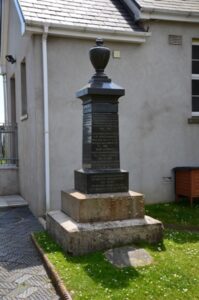
The Great War, 1914-1918
William Lloyd Davies, Second Lieutenant, Royal Welsh Fusiliers. William was born on 3 April 1894, the son of John George Davies, and Mary Davies, of Coombe Park, Peniel. He was educated at Carmarthen Grammar School, before passing into the University of London, and joined the Artists Rifles in November 1915. William was then commissioned on 7 July 1916, and joined the 13th Battalion, Royal Welsh Fusiliers in Belgium in August. The battalion was rebuilding after its mauling at Mametz Wood, and was attached to 113 Brigade, 38th (Welsh) Division. The Division was in the trenches at Boesinghe when William joined them, and remained here until launching their assault on Pilckem Ridge on 31 July 1917. William was killed during the attack on Pilckem that day, and was reportedly buried at Caesars Nose Cemetery. He now lies in Dragoon Camp Cemetery, Belgium. He was 23 years old.
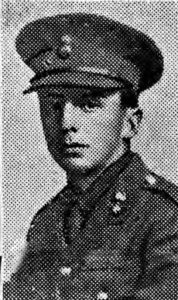
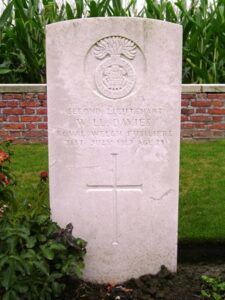
John Griffiths, Sergeant, 13126, Welsh Regiment. John lived at Brynhyfryd, Peniel, and was the son of David Griffiths, of the Post Office, Bronwydd Arms. He enlisted at Tumble into the 9th Battalion, Welsh Regiment, which was attached to 58 Brigade, 19th (Western) Division. The battalion crossed to France on 18 July 1915, and moved with the division to positions near Loos. The Division fought during the opening attack of the Battle of Loos, and then moved to the Somme, where they took part in the second wave of the attack on Ovillers-La Boiselle on 1 July, capturing the village at heavy cost, and fought through the Somme Battles of Pozieres and the Ancre in 1916. They then moved North to Ypres, taking part in the Battle of Messines, and fought on the Menin Road and at Polygon Wood, before moving up to Broodseinde, Poelcapelle and Passchendaele Village itself. In 1918 they were caught up in the German Spring Offensive near St. Quentin, where they suffered terrible casualties, and fought at the Battle of Bapaume. They moved to Ypres, but were caught up in the German attack at Messines, and at Bailleul, and Kemmel. After suffering terribly again, they moved south to the quieter French sector to rebuild, but were caught up in the German offensive on the Aisne, and fought during the Battle of the Selle, Valenciennes, the Sambre and the Passage of the Grand Honelle. John was killed during the Battle of the Sambre, on 4 November 1918, aged 23. He is buried at Cross Roads Cemetery, Fontaine-Au-Bois.
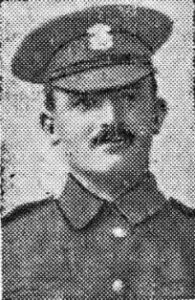
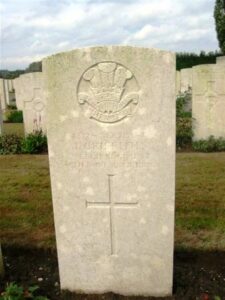
Walter James, Private, 203066, South Lancashire Regiment. Walter was born in 1885, the son of Thomas James and Rachel James (nee Harries), of Llettywithig Farm, Abergwili. Walter enlisted into the army at Llanelli, probably the 4th Battalion, Welsh Regiment, but became transferred to the 2/4th Battalion, South Lancashire Regiment. The battalion had formed at Warrington in September 1914, moving to Ashford in February 1915 to join 172 Brigade, 57th Division. In June 1916 the division moved to Mytchett, Aldershot, then in October 1916 to Blackdown. On 16 February 1917 the division landed at Boulogne and moved to the ‘Nursery Sector’ around Armentieres. The 2/4th South Lancs moved into trenches near Bois Grenier on 24 February to begin its first tour in the front line in what was by now a relatively quiet sector. Over the coming weeks the battalion carried out the by now usual routines of four days in the trenches, four in support and four in reserve, as the men acclimatised to life at the front. On 1 April the battalion moved to the Laundries at Erquinghem and remained there for ten days before marching back towards the line and on 13 April moved into trenches in the Rue du Bois Sector. Walter was wounded by shellfire during this tour in the trenches and was evacuated to Hazebrouck, where he died of his wounds on 19 April 1917. The 32-year-old was buried in Hazebrouck Communal Cemetery. His parents had by now retired from farming and moved to Wauniago, Picton Place, Carmarthen.
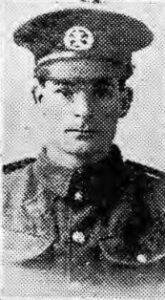
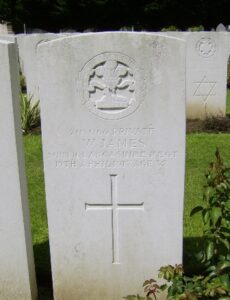
William Lewis, Private, 267153, Notts & Derby (Sherwood Foresters). William was the son of John and Anne Lewis, of Pentrefynis Farm, Peniel. He enlisted at Hounslow into the army, and at some time during 1916 was posted to the 1/5th Battalion, Sherwood Foresters, which was in France attached to 139 Brigade, 46th (North Midland) Division. During March 1917 the Division followed the German Retreat to the Hindenburg Line, and then fought in the Battle of Arras, taking part in the Battle of Hill 70. In 1918 the Division took part in the Advance in Flanders, and then moved south, where they were tasked with the breaking of the Hindenburg Line. They fought at the Battle of the St Quentin Canal at the end of September, where the 137th Brigade completed one of the finest feats of arms in British military history, when it forced the crossing of the St Quentin Canal at Riqueval. William was killed soon after, on 3 October 1918, aged 27. He is buried at Ramicourt British Cemetery, France.
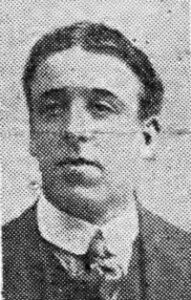
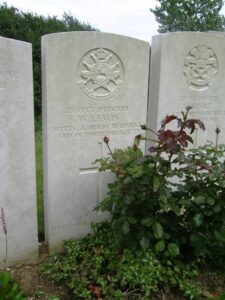
William Alcwyn Lewis, Private, 2381989, Canadian Infantry. William was born on 4 January 1883, the son of John and Elizabeth Lewis, of Peniel Cottage, Rhydargaeau. He had emigrated to Canada prior to the war, and resided at 268, Spence Street, Winnipeg. William had enlisted in 1917, but was called up on 17 April 1918, joining the 96th Battalion (Canadian Highlanders), Canadian Infantry. William didn’t serve overseas. He became ill and died on 21 January 1919, aged 36, and is buried at Montreal (Mount Royal) Cemetery, Canada.
John Rees Morgan, Private, 2118, Welsh Guards. John was the son of David and Rachel Morgan, of Peniel Road, Carmarthen. He enlisted at Carmarthen into the 1st Battalion, Welsh Guards, which was raised in February 1915, and moved to France in August 1915, attached to 3rd Guards Brigade, Guards Division. The Welsh Guards saw their first major action during the Battle of Loos on 25 September 1915, and remained in the area during the coming months. In July 1916 the Division moved to the Somme, where they fought at the Battle of Flers-Courcelette, and then at the Battle of Morval, capturing Lesboeufs Village. The Guards stayed on the Somme over the winter, and it was here that John was killed, on 10 December 1916, aged 29. He is commemorated on the Thiepval Memorial, France.
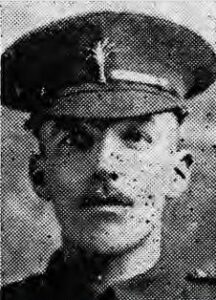
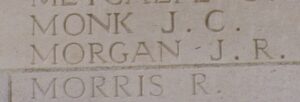
Dan Ivor Price, Private, 40048, Royal Welsh Fusiliers. Dan was born in 1896, the son of David Price and Margaret Elizabeth Price (nee Davies), of Peniel School House, Abergwili. His father was the Schoolmaster at Abergwili for several years prior to moving with the family to Chapel House, Peniel, following the death of his wife. Dan was educated at Carmarthen Grammar School, and moved to Tumble prior to the war, gaining work there as a school teacher. Dan left his job as a teacher at Tumble to enlist at Carmarthen into the 22nd Battalion, Royal Welsh Fusiliers on 10 December 1915, and was initially placed on the Army Reserve. He was mobilised on 21 January 1916, travelling to Conway to then join the battalion at Kinmel Park. On 28 July 1916 Dan was drafted to France and two days later was posted to the 1st Battalion, Royal Welsh Fusiliers, which was on the Somme, attached to 22 Brigade, 7th Division. The Division had taken part in the opening assault of the Somme offensive on 1 July 1916, advancing from positions near Bois Francais, near Fricourt, and capturing the village of Mametz, one of the few successes of 1 July 1916. The battalion then took part in further attacks to push forwards, to the south of Mametz Wood, and upon being relieved, witnessed the troops of the 38th (Welsh) Division moving forward to launch its assault on Mametz Wood. On 14 July, with the wood taken, the 7th Division moved back into the line, with orders to capture Bazentin-le-Petit, before taking part in the terrible attacks on High Wood over the coming days. On 22 July the 1st RWF was relieved, moving back into reserve to rest and rebuild at La Chaussee. By 12 August the battalion had moved forwards to Dernancourt, and on 26 August marched further forward, to take part in the Divisions assault on Ginchy. The Division saw heavy fighting over the coming days, before the 1st RWF had another short break, but on 1 September the battalion received orders to push forwards again to launch a fresh assault on Ginchy from Montauban Alley. On 3 September 1916 the 1st RWF launched its assault, but suffered severe casualties, with over 200 officers and men killed, wounded or missing. The division was then relieved and transferred north to the Ypres Salient to rest and rebuild, in positions near Ploegsteert Wood, but at the beginning of November was ordered to move south, back to the Somme Sector, where it wintered. On 25 February 1917 patrols discovered that the Germans had evacuated Serre, so the 1st RWF received orders to advance and seize the village of Puisieux. Dan was killed in action here on 26 February 1917, when the advancing troops became held up by intense German artillery fire. The 20-year-old has no known grave and is commemorated on the Thiepval Memorial, France. Dan is not commemorated at Abergwili.
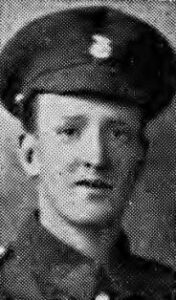
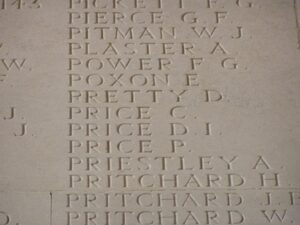
David Richards, Ordinary Seaman, J/47681, Royal Navy. David was born at Llanllawddog on 29 January 1891, the son of John and Elizabeth Richards. By 1901 the family had moved to Harpley Green, Clifton on Ferme, Worcester. David had returned to Peniel by the outbreak of war and enlisted into the Royal Navy on 16 December 1915. After training at HMS Victory he was posted aboard the battleship H.M.S. Invincible, which was attached to the 1st Battle Squadron of the Home Fleet. The Invincible saw action at the Battle of Heligoland Bight, and at the Battle of the Falkland Islands, before taking part in the famous Battle of Jutland on 31 May 1916. She took a direct hit from a salvo from the SMS Lutzow, blowing up with the loss of over 1,000 of her crew, including 25 year old David. He is commemorated alongside his crewmates on the Portsmouth Naval Memorial, Hampshire.
World War Two, 1939-1945
James Glyn Davies, Flying Officer, 175652, Royal Air Force Volunteer Reserve. James was the son of Thomas and Mary Davies, of Carmarthen, and the husband of Hannah May Davies, of Carmarthen. He served with 166 Squadron, Royal Air Force, which was a heavy bomber unit, equipped with the Avro Lancaster III, based at RAF Kirmington. James was killed when his Lancaster Mark III, Serial LM722 was shot down while returning from a raid on Germany on 24 September 1944. He was 31 years old, and is commemorated on the Runnymede Memorial, Surrey.